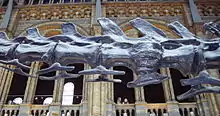Chevron (anatomy)
A chevron is one of a series of bones on the ventral (under) side of the tail in many reptiles, dinosaurs (such as Diplodocus; see picture), and some mammals such as kangaroos and manatees.[1][2][3]

Diplodocus chevron

Caudal vertebrae of Diplodocus carnegii showing the double-beamed chevron bones that the genus name refers to, Natural History Museum, London.
Their main function is to protect critical elements in the tail such as nerves and blood vessels from being damaged when the animal either supports its weight on its tail, or pushes it against a hard surface to propel itself and they are homologous to ventral arches in the vertebrae of fishes.[4]
References
- "Palaeos Vertebrates: Glossary Ch-Co". palaeos.com. Retrieved 2021-02-01.
- magazine, Sid Perkins,Nature. "Tails Tell the Tale of Dinosaur Sex". Scientific American. Retrieved 2021-02-01.
- "NOVA | Bone Diggers | Anatomy of Thylacoleo | PBS". www.pbs.org. Retrieved 2021-02-01.
- Functional anatomy of the vertebrates : an evolutionary perspective. Liem, Karel F., Walker, Warren F. (Warren Franklin) (3rd ed.). Fort Worth: Harcourt College Publishers. 2001. ISBN 0-03-022369-5. OCLC 45406536.CS1 maint: others (link)
This article is issued from Wikipedia. The text is licensed under Creative Commons - Attribution - Sharealike. Additional terms may apply for the media files.